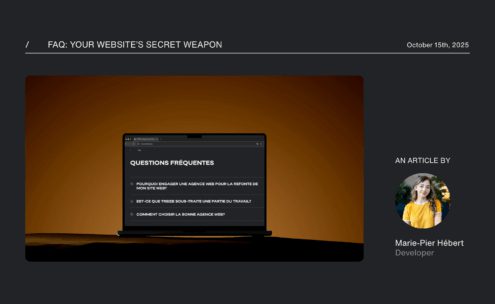When the idea of building a website for our business arises, our initial thoughts often revolve around a flashy design and top-notch interactivity to convert as many clicks as possible into product or service purchases.
In practical terms, we have two choices: a one-pager, simple, clean, easy to read and understand, or a more traditional website with multiple pages, including a blog, team page, contact page, possibly a product page, and well-organized content in sections.
So, which option is more suitable for my needs when it comes to creating my website? This is a crucial question in the completion of such a project, and the best way to answer it is to compare these two types of structures and assess them against our expectations.
one page to rule them all
The explosion of the one-page trend a few years ago is simply a result of its simplicity in programming and its overall construction, the desire to create something beautiful, simple, effective, and quickly. Due to its linear and pleasant user experience, this format has proven to be ideal for presenting an idea, a product, a service, or telling a story.
ITS STRENGHT? THE scroll!
If the memory of a previous reading comes back to you, that’s normal. If there’s a good reason for the one-page design, it’s because, of all our online behaviors, scrolling represents the most spontaneous and repeated action in our navigation. It’s much easier to scroll the page to continue reading and find other pieces of information than having to follow an endless list of links to change pages at the end of each paragraph.
Thanks to a smooth, concise, and logical presentation of content, you achieve a more attentive user who, if your work is well done, is more likely, according to some studies, to convert their click in favor of your business.
So, it’s easy to understand why there is so much interest in a website that presents an idea, a project, a product, or a person in a narrative way. However, the concept of uniqueness is essential. If your project involves several distinct elements, or if your desire is to offer dynamic content to update over time (like a blog), opting for a classic website is a more suitable choice.
the more pages you have, the more click (cheesy phrase/100)
The era of a one-page website is pretty much over.
More and more organizations and solo entrepreneurs are turning to more complex website structures, allowing them to clearly categorize all their information and offer dynamic content to their users. Smart links and well-segmented sections make page-to-page navigation smoother than before.
ideal for digitizing your inventory.
While Canada may show a slight delay in terms of online sales, the web is going to be the number one platform for retail sales and purchases worldwide in the future. We no longer emphasize the importance of online commerce, but what could be better for a store than being well-organized with sections that facilitate purchases? A well-crafted product page, user-friendly design, and relevant links ensure a high conversion rate.
Even though the SEO of a One Page site is not necessarily in dire straits, the SEO of a complex site occurs more naturally, and search engines greatly favor content divided into pages with a well-structured syntax. We won’t list the advantages of having a blog page here, but it also significantly aids in your organic SEO.
Where a One Page site tends to be rather rigid, ephemeral, and limited, the complex site provides dynamism and longevity often more suitable for the desire of a well-established online presence.
Conclusion
There’s no one-size-fits-all solution that applies to all websites. The thought process arising from your brainstorming should revolve around one question: Does everything fit in? The real answer to this question lies in your site’s ability to present all the information you want to convey while offering a pleasant user experience.
You might opt for a One Page or a site with just a few pages summarizing all the information on the homepage when the idea is to present a single product or a single story, in the form of a temporary mini-site with smooth animations that pique the desire to learn more (video game companies do this very well).
However, when your project exceeds a certain scope or when your desire is for dynamic content that can grow over time, the choice of a complex site with multiple pages remains ideal. You’ll need to think about how to transform this wealth of information into a enjoyable and seamless experience, without overwhelming the user with convoluted navigation or superfluous features.
An increasingly popular approach is being considered by the web designers of the future. Many sites with a comprehensive homepage, in addition to including the winning SEO package of a store and a blog, are emerging and trying to combine the best of these two formats.



